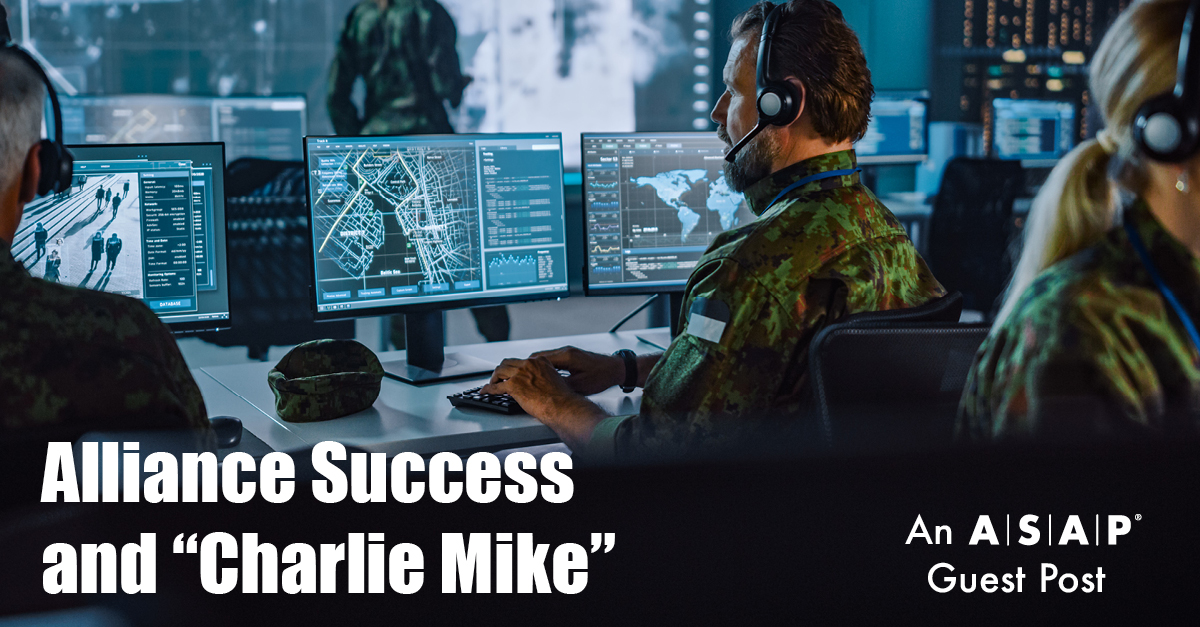Guest Post: Alliance Success and “Charlie Mike”
What am I trying to accomplish? Why am I trying to accomplish this instead of that? Can I accomplish that objective with the resources I currently have at my disposal? What resources am I lacking, and how important are they to the completion of the objective? If I don’t have those resources, where can I get them? Do I have allies that have them? By pooling resources, can we achieve the desired outcome faster and better—making us, as Peter Drucker would put it, the “fustest with the mostest”?
These questions have been asked by military commanders for thousands of years. Scipio Africanus probably asked himself these exact questions when faced with the advancing Hannibal astride a cavalry of thundering elephants. As dissimilar as the two roles may seem, these questions could also be, and surely have been, asked by strategic alliance managers since the first joint business venture. Once you get below the surface of the obvious differences, where the real thinking gets done, you quickly see that the skills and abilities necessary to be successful in either field are fungible. I know this firsthand as a former US Army Warrant Officer and presently a head of strategic alliances.
When planning a military operation, the commander takes an assessment of the battlefield. He or she needs to know the objective, how that objective reflects the commander’s intent, what resources are available, what resources are not available, how wide and important that gap is, and how it’s going to be filled. In a military context, this could mean, for example, that operators from the US Army Rangers and UK SAS are joined by Australian medics, riding on US Navy equipment, in support of a CENTCOM objective, part of a broader UN strategy. That commander knows that the outcome of the mission could have a significant impact on the wider efforts and that failure is simply not an option. That means meetings are held, favors are called in, support is both provided and received, and a team is assembled that while differing in individual capability, is aligned in purpose against a single objective: Move out. Draw fire. Charlie Mike.
The Mission Is Not Impossible When You Have Allies
For those of you unfamiliar with the term, “Charlie Mike” (or the acronym, CM) is a military reference to a mindset that effectively means, no matter what happens, no matter what the adversary throws at us, no matter what hardships or challenges we face: Continue. The. Mission.
Whether it’s a mission-critical combat objective or a customer-driven business objective, the skills, planning, coordination, and execution are the same for both the military commander and the strategic alliance manager. When faced with a customer need that an organization cannot hope to meet in isolation, failure is not an option and allies must be sought out.
For example, my company, Nuix, provides software that performs a specific function, our core competency. We are not all things to all people and don’t intend to be, so we need to work with our technology partners to fulfill the mission objectives that our software does not natively provide. As a pure-play software company, we do not have a consulting division, for example, so if extended services are required by the customer, then we will need a partner to provide that capability. Together with our partners, we have formed a functional team of differently abled operators with a singular focus: meet the customer’s need. No matter what the challenges are, no matter how daunting the problem seems, Charlie Mike.
Speed, Scale, and Collaboration Help Alliances Avoid Getting Lost in Space
In the military, these functional teams are called joint task forces or JTFs; in the alliance world they are commonly referred to as ecosystem solutions. Slightly different names (and no cool acronyms—I need to work on that one) but identical approaches, with the whole being greater than the sum of its parts. In the current operating environment (market), speed and scalability are tantamount to success. This combination of mature business operations and entrepreneurial malleability will be what defines organizational success in the years to come. The days of the monolithic organizations like Bell Labs, Delco Electronics, and Wang Computers have given way to a plethora of nimble startups, platform software companies, cloud SaaS providers, and global service providers. This market diversification has been driven in part by the ubiquity of technology, the introduction of data security and privacy legislation, and the resulting increasingly complex customer requirements.
Computing speeds, storage capacity, and networking capabilities—among other developments—are now well beyond what anyone could have imagined just a few years ago. This has led to technology advancements that have actually outpaced the capacity of business to build organizational processes sufficient to adequately harness their geometric growth. This means that now more than at any other time in the history of commerce on this planet, we need to be looking for ways to collaborate in a manner that creates value for the customer and enhances our collective capability and capacity—something none of us could hope to achieve in isolation.
But what an exciting time to be an alliance professional! There is so much potential waiting to be tapped into and so many new missions we can go on together, I feel a bit like John Robinson on the Netflix reboot of Lost in Space. Yet despite all these advancements, the challenge for us, as for the military commander, remains the same: What is our objective? Wat resources are we going to need? Do we have those resources? If not, who does? And finally: How can we work together to accomplish the mission?
I hope you will join me on this most excellent and exciting journey.
Charlie Mike!
Christopher Pogue is senior vice president and head of strategic alliances at Nuix, and a former US Army Warrant Officer.

